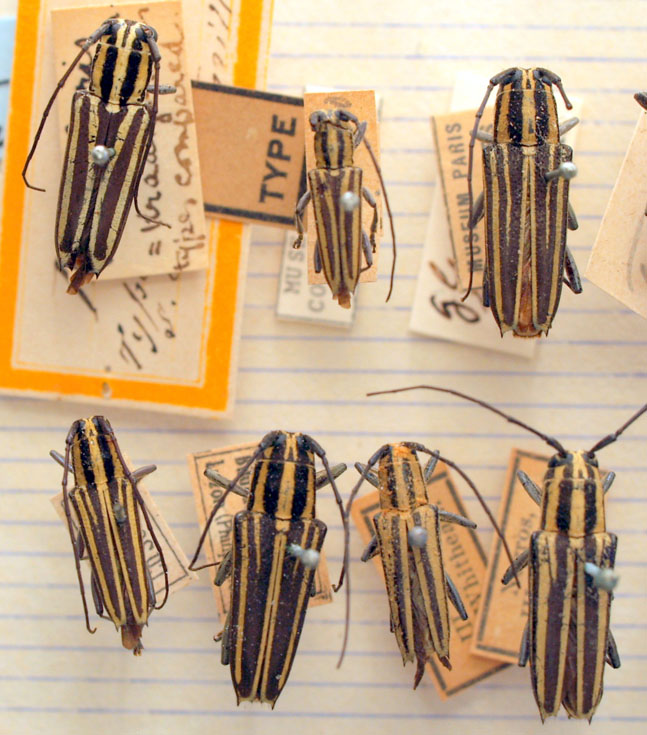| Author |
 Topic Topic  |
|
|
Andre
Member Rosenbergia
   
Germany
1692 Posts |
 Posted - 08/01/2017 : 14:14:47 Posted - 08/01/2017 : 14:14:47



|

41.83 KB
Luzon, Aurora Prov., Female, 13 mm. |
Edited by - Xavier on 26/01/2017 18:41:02 |
|
|
Xavier
Scientific Collaborator
    
France
12068 Posts |
 Posted - 08/01/2017 : 15:08:42 Posted - 08/01/2017 : 15:08:42



|
Glenea (Vittiglenea) kraatzii Thomson, 1865 ?
Same species here.
Breuning's drawing (1956) here shows a species a little bit different, so I am not sure of the ID. |
Edited by - Xavier on 08/01/2017 15:19:35 |
 |
|
|
jplami
Member Rosalia
  
France
656 Posts |
|
|
Xavier
Scientific Collaborator
    
France
12068 Posts |
 Posted - 15/01/2017 : 15:49:21 Posted - 15/01/2017 : 15:49:21



|
| Ok, c'est aussi ce que j'avais fini par comprendre en revoyant des photographies, prises au mnhn, de spécimens semblables à celui d'Andre. |
 |
|
|
Andre
Member Rosenbergia
   
Germany
1692 Posts |
 Posted - 26/01/2017 : 09:18:52 Posted - 26/01/2017 : 09:18:52



|
I mean this Spec. is not G. kraatzi. The Lateralmargin from the pronotum is basal distinctly constricted !
By the picture by Breuning 1956 more or less straigth like this one.
|
 |
|
|
Xavier
Scientific Collaborator
    
France
12068 Posts |
 Posted - 26/01/2017 : 09:48:55 Posted - 26/01/2017 : 09:48:55



|
quote:
Originally posted by jplami
oui, il correspond à l'holotype de Glenea (Vittiglenea) kraatzii Thomson, 1865
Le dessin représente probablement une variation.
Holotype specimen of G. kraatzii is here and drawing probably shows a variation. |
 |
|
|
Andre
Member Rosenbergia
   
Germany
1692 Posts |
 Posted - 26/01/2017 : 09:57:25 Posted - 26/01/2017 : 09:57:25



|
Ok, sorry.... i have no look in the Type section  . .
Than is this one G. kraatzii T.
The similar Spec. with basal widened Pronotum is than clearly a other Species ! Breunings picture is also not G. kraatzii !
Thanks.... |
Edited by - Andre on 26/01/2017 09:59:04 |
 |
|
|
Xavier
Scientific Collaborator
    
France
12068 Posts |
 Posted - 26/01/2017 : 11:05:36 Posted - 26/01/2017 : 11:05:36



|
Yes, a variation or 2 mixed species ? ...I do not know in fact.
At MNHN Paris, both forms are present under the same name :

Photographie G. Chemin
First specimen is the holotype. |
Edited by - Xavier on 26/01/2017 11:19:19 |
 |
|
|
Andre
Member Rosenbergia
   
Germany
1692 Posts |
 Posted - 26/01/2017 : 11:39:22 Posted - 26/01/2017 : 11:39:22



|
Für mich zwei unterschiedliche Arten !
G. kraatzii mit basal verengtem Pronotum und ohne hell tomentierter Naht vor dem Schildchen.
Bei der zweiten Art geht die gelbe Tomentierung der Naht bis zum Schildchen und das Pronotum ist nach hinten eher etwas verbreitert. Auch sind die Wangen bei meinen Tieren deutlich länger als bei G. kraatzii ! |
 |
|
|
Xavier
Scientific Collaborator
    
France
12068 Posts |
 Posted - 26/01/2017 : 13:43:36 Posted - 26/01/2017 : 13:43:36



|

160.93 KB
a female specimen from east Luzon to compare |
 |
|
|
Gerard
Scientific Collaborator
    
France
5265 Posts |
 Posted - 26/01/2017 : 17:55:40 Posted - 26/01/2017 : 17:55:40



|
En fait je pense qu’il y a un problème avec le type de Glenea (Vittiglenea) kraatzii Thomson, 1865.
Le type ne correspond pas à la série et il y a une autre espèce Glenea regularis Newman, 1842 qui est identique en tout point au type de G.kraatzii.
Voici la description de Glenea regularis Newman, 1842
Cerambycitum Insularum Manillarum Dom. Cuming captorum enumeratio digesta. The Entomologist, London 19: 298-305.
81. Glenea regularis.
Lanuginosa, flavescenti nigroque varia: antennae nigrae; oculi nigri, flavescenti circumdati; epicranii lineis 2 approximatis longitudinalibus; prothoracis lineis 5 longitudinalibus sternoque ; scutello ; utriusque elytrii lineis 3; abdomineque fere toto fulvescentibus. (Corp. long. '5 unc. lat. •175 unc.)
Le gros problème c’est que les descriptions de Thomson et de Newman sont très courtes et peuvent correspondre au deux bêtes ? |
Edited by - Gerard on 26/01/2017 17:57:02 |
 |
|
|
Gerard
Scientific Collaborator
    
France
5265 Posts |
 Posted - 26/01/2017 : 18:34:35 Posted - 26/01/2017 : 18:34:35



|
Voici ici le lien sur le site de Larry ou l'ont trouve le type de Glenea regularis Newman 1842
|
 |
|
|
Xavier
Scientific Collaborator
    
France
12068 Posts |
 Posted - 26/01/2017 : 18:39:54 Posted - 26/01/2017 : 18:39:54



|
| I think Gérard is right, your specimen should be a Glenea regularis Newman, 1842. |
Edited by - Xavier on 26/01/2017 19:20:02 |
 |
|
|
Francesco
Forum Admin
    
Luxembourg
9416 Posts |
 Posted - 26/01/2017 : 19:07:06 Posted - 26/01/2017 : 19:07:06




|
In fact: the original description stated "utriusque elytrii lineis 3", i.e. ~3 lines on each elytron.
The specimens with discal strips can not belong to this species. |
 |
|
|
Xavier
Scientific Collaborator
    
France
12068 Posts |
 Posted - 26/01/2017 : 19:24:12 Posted - 26/01/2017 : 19:24:12



|

Original description of Glenea (Vittiglenea) kraatzii Thomson, 1865

Glenea (Vittiglenea) kraatzii Thomson, 1865 Drawing by Breuning (1956), Pl.I, fig. 9.
|
Edited by - Xavier on 26/01/2017 19:28:40 |
 |
|
| |
 Topic Topic  |
|


